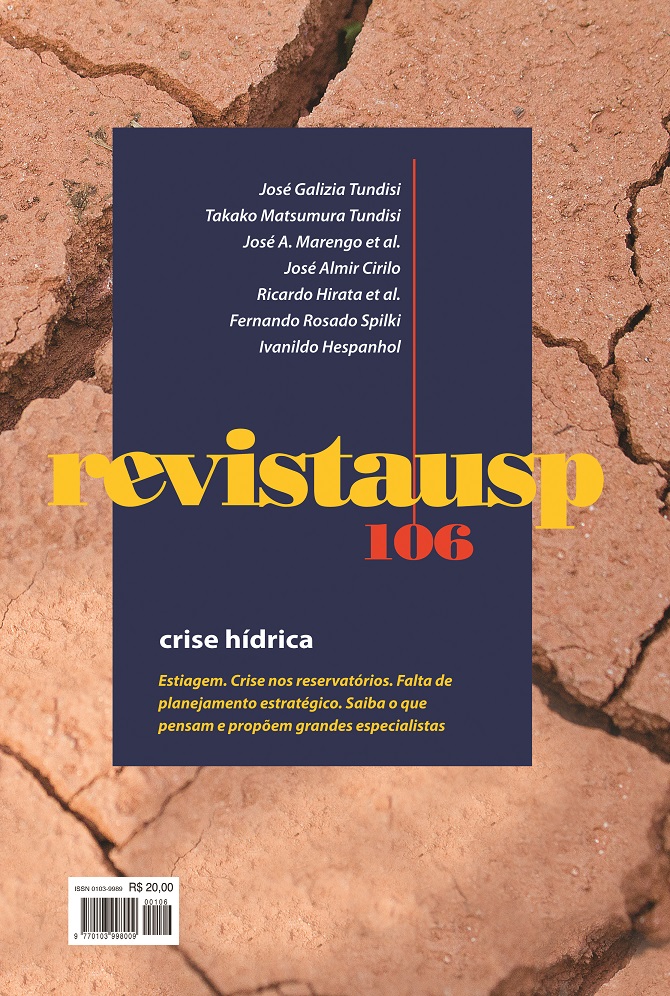Crise hídrica, saúde e parâmetros de qualidade microbiológica da água no Brasil
DOI:
https://doi.org/10.11606/issn.2316-9036.v0i106p71-78Keywords:
water quality, microorganisms, waterborne diseasesAbstract
Viruses and other microorganisms are responsible for waterborne diseases such as gastroenteritis and hepatitis. The microbial contamination markers currently adopted (fecal coliforms) already show how seriously Brazilian waters are contaminated by fecal matters. However, some evidences suggest that additional parameters should be adopted for monitoring the microbiological quality of water. The extent of waste collection and treatment activities in Brazil is alarming; and waste is a major source of contamination of our waters. Also, microbial contamination agents are only partially monitored, and all of these factors lead to the current situation in which we are faced with various endemic waterborne diseases. Such vulnerable situation is likely to aggravate more when water is scarce.Downloads
References
BOSCH, A.; ABAD, F. X.; PINT, R. M. “Human Pathogenic Viruses in the Marine Environment”, in Shimshon Belkin & Rita R. Colwell (eds.). Oceans and Health: Pathogens in the Marine Environment. New York, Springer, 2005, pp. 109-32.
FUMIAN, T. M.; VIEIRA, C. B.; LEITE, J. P. G.; MIAGOSTOVICH, M. P. “Assessment of Burden of Virus Agents in an Urban Sewage Treatment Plant in Rio de Janeiro, Brazil”, in Journal of Water and Health, 11(1), 2013, pp. 110-9. Disponível em: http://doi.org/10.2166/wh.2012.123.
GIRONES, R. et al. “Molecular Detection of Pathogens in Water – The Pros and Cons of Molecular Techniques”, in Water Research, 44(15), 2010, pp. 4.325-39. Disponível em: http://doi.org/10.1016/j.watres.2010.06.030.
GREER, A.; NG, V.; FISMAN, D. “Climate Change and Infectious Diseases in North America: The Road Ahead”, in Canadian Medical Association Journal, 178(6), 2008, pp. 715-22. Disponível em: http://doi.org/10.1016/j.cgh.2012.05.002.
HASSINE-ZAAFRANE, M.; AOUNI, M. “Viral Gastroenteritis: Etiologic Agents, Epidemiology and Management”, in Amrit Bandopadhyay & Lokesh Prajapati (eds.). Gastroenteritis: Epidemiology, Management and Prevention, 2012, pp. 21-36. Laboratory of Infectious Diseases and Biological Agents, Faculty of Pharmacy, University of Monastir, Monastir, Tunisia: Nova Science Publishers, Inc. Disponível em: http://www.scopus.com/inward/record.urleid=2s2.084892359940&partnerID=40&md5=15edb63933a44b5dd4ecc8bb19f6f178.
HOFSTRA, N. “Quantifying the Impact of Climate Change on Enteric Waterborne Pathogen Concentrations in Surface Water”, in Current Opinion in Environmental Sustainability, 3(6), December 2011, pp. 471-9. Disponível em: http://doi.org/10.1016/j.cosust.2011.10.006.
JIANG, S. C.; CHU, W.; HE, J. W. “Seasonal Detection of Human Viruses and Coliphage in Newport Bay, California”, in Applied and Environmental Microbiology, 73(20), 2007, pp.6.468-74. Disponível em: http://doi.org/10.1128/AEM.01370-07.
KISHIDA, N. et al. “Quantitative Detection of Human Enteric Adenoviruses in River Water by Microfluidic Digital Polymerase Chain Reaction”, in Water Science and Technology: a Journal of the International Association on Water Pollution Research, 70(3), 2014, pp. 555-60. Disponível em: http://doi.org/10.2166/wst.2014.262.
LIPP, E. K.; FUTCH, J. C.; GRIFFIN, D. W. “Analysis of Multiple Enteric Viral Targets as Sewage Markers in Coral Reefs”, in Marine Pollution Bulletin 54(2), 2007, pp. 1.897-902. Disponível em: http://doi.org/10.1016/j.marpolbul.2007.08.001.
MATTISON, K.; BIDAWID, S. “Analytical Methods for Food and Environmental Viruses”, in Food and Environmental Virology, 1(3-4), 2009, pp. 107-22. http://doi.org/10.1007/s12560-009-9017-6.
OKOH, A. I.; SIBANDA, T.; GUSHA, S. S. “Inadequately Treated Wastewater as a Source of Human Enteric Viruses in the Environment”, in International Journal of Environmental Research and Public Health, 7(6), 2010, pp. 2.620-37. Disponível em: http://doi.org/10.3390/ijerph7062620.
REYNOLDS, K. A. “Integrated Cell Culture/PCR for Detection of Enteric Viruses in Environmental Samples”, in Methods in Molecular Biology (Clifton, N.J.), 268, 2004, pp. 69-78. Disponível em: http://doi.org/10.1385/1-59259-766-1:069.
VECCHIA, A. D. et al. “First Description of Adenovirus, Enterovirus, Rotavirus and Torque Teno Virus in Water Samples Collected from the Arroio Dilúvio, Porto Alegre, Brazil”, in Brazilian Journal of Biology, 72(2), 2012, pp. 323-9. Disponível em: http://doi.org/10.1590/S1519-69842012000200013.
VIEIRA, C. B. et al. P. “Detection of Enteric Viruses in Recreational Waters of an Urban Lagoon in the City of Rio de Janeiro, Brazil”, in Memórias do Instituto Oswaldo Cruz, 107(6), 2012, pp. 778-84. Disponível em: http://doi.org/10.1590/S0074-02762012000600012.
WEI, J.; JIN, Y.; SIMS, T.; KNIEL, K. E. “Internalization of Murine Norovirus 1 by Lactuca Sativa During Irrigation”, in Applied and Environmental Microbiology, 77(7), 2011, pp. 2.508-12. Disponível em: http://doi.org/10.1128/AEM.02701-10.
Downloads
Published
Issue
Section
License
Copyright (c) 2016 Revista USP

This work is licensed under a Creative Commons Attribution-NonCommercial-ShareAlike 4.0 International License.
|
Pertence à revista. Uma vez publicado o artigo, os direitos passam a ser da revista, sendo proibida a reprodução e a inclusão de trechos sem a permissão do editor. |


